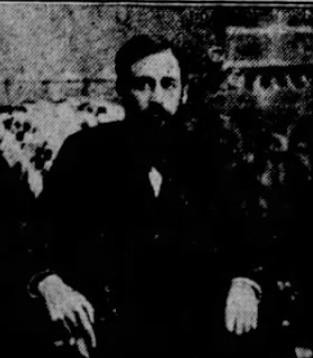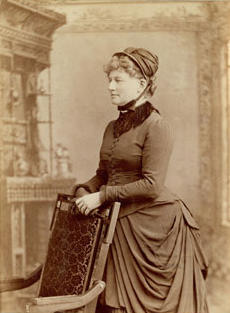The unnamed Saint Paul clergyman was Cassius Marcus Terry, who later joined the Geological and Natural History Survey of Minnesota and worked at the university’s General Museum where Cardigan’s mount was first displayed. Coincidentally, the survey began in 1872, the same year Cassius arrived in Minnesota.
Born in Clymer, New York on July 21, 1845, Cassius Marcellus Terry was the youngest of nine children of Silas Terry and Polly Powers. Named after a prominent abolitionist, Cassius graduated from Amherst College in 1867 and Union Theological Seminary in 1870. He married Emily Hitchcock, nearly seven years his senior, on May 18, 1870, in Boston, Massachusetts. However, sometime before his marriage, Cassius contracted tuberculosis. In efforts to restore his health Cassius thrust himself into various outdoor activities, including geology after he married a geologist’s daughter. Cassius was an eloquent orator with a brilliant mind and eclectic interests that ranged from religious tenets to geology, hydrology, and history. He was equally comfortable giving sermons, writing of hydrogeology, or lecturing on the defeat of the Spanish Armada.
Emily was the youngest child of Edmond Hitchcock, president of Amherst College, and Orra White, one of the earliest women botanical and scientific illustrators in America. Edmond was one of the foremost early American geologists and gained fame for his collection of Connecticut River Valley dinosaur tracks. Orra created most of the illustrations for Edmond’s work but was an accomplished botanist in her own right. She apparently instilled her scientific interests and artistic talents in their youngest child, as Emily became one of Minnesota’s most skilled early botanists and scientific illustrators. Edmond died before Cassius and Emily married but Emily’s brother Charles followed his father’s path becoming a geology professor at Dartmouth College. Charles was also the mentor of Warren Upham, who joined the Geological and Natural History Survey of Minnesota in 1879, where he and Cassius worked as colleagues.
Although the Terrys hoped to join the New Bedford, Massachusetts Trinitarian Church congregation right after their marriage, a severe hemorrhage postponed Casius’ plan. Instead, the couple began married life boarding with a farming family in Bethlehem, New Hampshire where Cassius spent time riding horseback through the hills to recover his health. Temporarily restored, Cassius moved to New Bedford in September of 1870, but within two years, his health again failed.
Tuberculosis was poorly understood at the time, but Minnesota’s climate was thought to help its victims. In 1886, Saint Paul built on that reputation when initiating their Winter Carnival. A preliminary visit convinced Cassius that Minnesota was a healthier place and his eloquent sermon at St. Paul’s Plymouth Congregational Church convinced that congregation that Cassius should lead their community. Their certainty was so strong that the congregation committed to building a new church just to entice Cassius and Emily to move to St. Paul. Built at the corner of Summit Avenue and Wabasha Street, the new church was close to what is now the Minnesota Peace Officers Memorial on the Capital’s southern grounds. While in Minnesota, Cassius continued to seek relief from his illness through outdoor activities, becoming an avid angler but also increasingly indulging his growing interest in geology.
The Terrys’ 1872 arrival in Saint Paul was shadowed by tragedy when their only child, five-month-old Edward Sweet Terry, died on July 19 - shortly after the new church’s cornerstone was laid. The church was finished and dedicated a year later, on the anniversary of Edwards’ death. Cassius led Plymouth church until September of 1877 when he was forced to resign because of his worsening health. He and Emily moved to St. Augustine, Florida for the winter before returning in May of 1878 to lead the First Congregational Church in Minneapolis while its pastor Edward Moore Williams was in Europe. The church’s location, less than a mile from the University of Minnesota facilitated his growing connection with the Geological and Natural History Survey of Minnesota. In 1879, Terry left the active ministry to concentrate on his geological work with the survey. The 1880 U.S. Census reflects this transition as Terry listed his occupation as Geologist & Clergyman, with geology taking precedence. Emily was listed as ‘Artist.’ At the time, the Terrys were boarding with Susan Walker at 1003 Sixth Street SE, just behind John Sergeant Pillsbury’s mansion (then Governor of Minnesota). Both homes are now the location of the university’s Pillsbury Court. During the summer, the Terry’s worked in northern and central Minnesota, while Cassius spent winters preparing thin sections and cataloguing samples for the General Museum. Yet, tuberculosis continued to haunt the couple’s lives. After completing a report on the state’s hydrogeology in February 1881, the Terrys went to Florida, but Cassius contracted a severe cold and after a month in St. Augustine, they left for Minnesota but were delayed for two months in Aiken, South Carolina because of Cassius’ declining health.
The Terrys returned to Minneapolis on June 1, 1881, but Cassius suffered the first of several severe hemorrhages on July 8 and died August 18, 1881. Emily left Minneapolis for a time after Cassius’ death but returned before 1884 to become the superintendent of ‘The Women’s Industrial Exchange of Minneapolis’, a self-help organization aiding women by providing a market for crafts and food products. In the fall of 1884, Emily let Minnesota for good, to become the head of Hubbard House, a student residence at Smith College in Northampton, Massachusetts. She spent the remainder of her life there, dying on February 6, 1921, at the age of eighty-three.
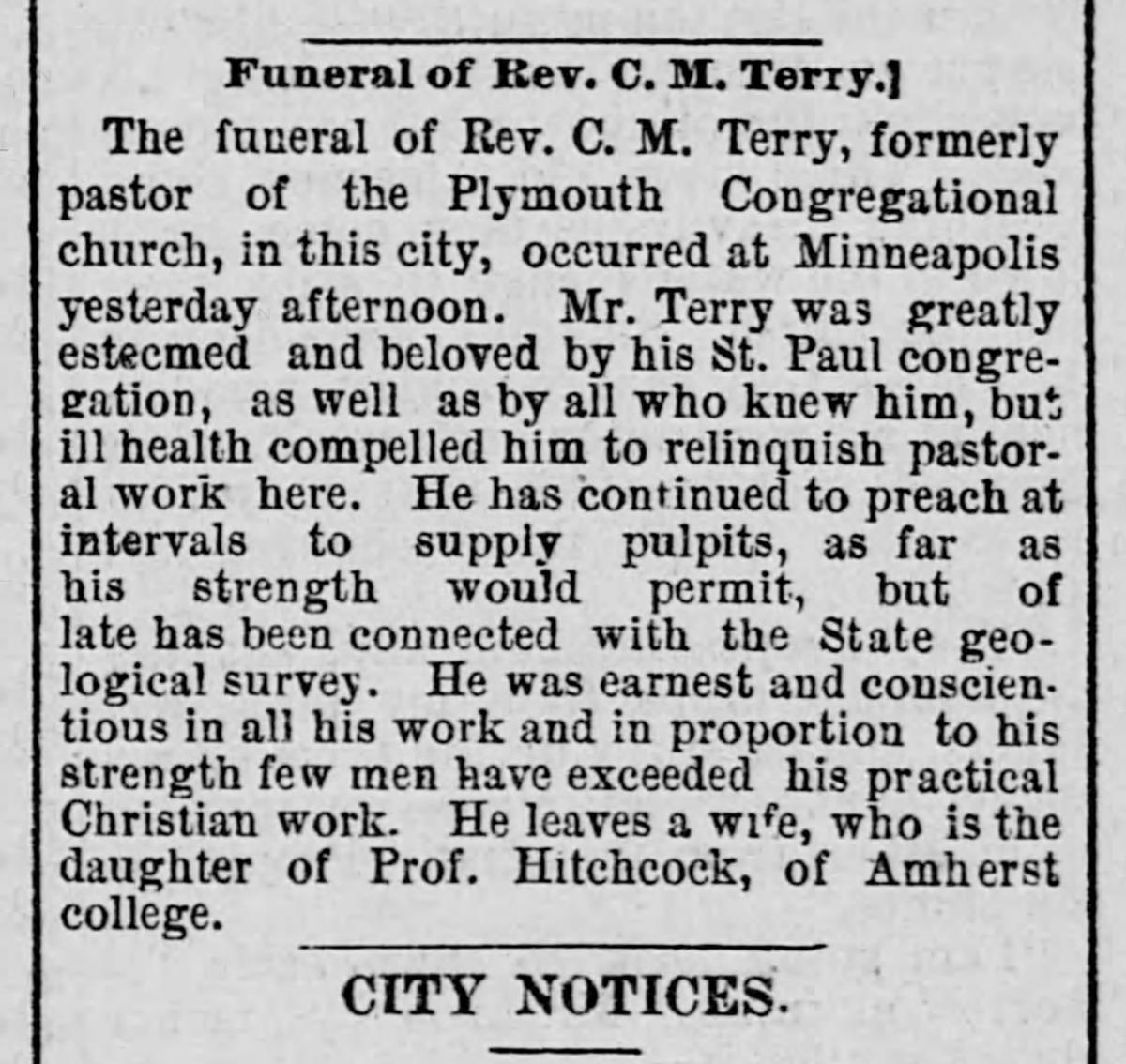
St. Paul Daily Globe report of Terry's death August 21, 1881.
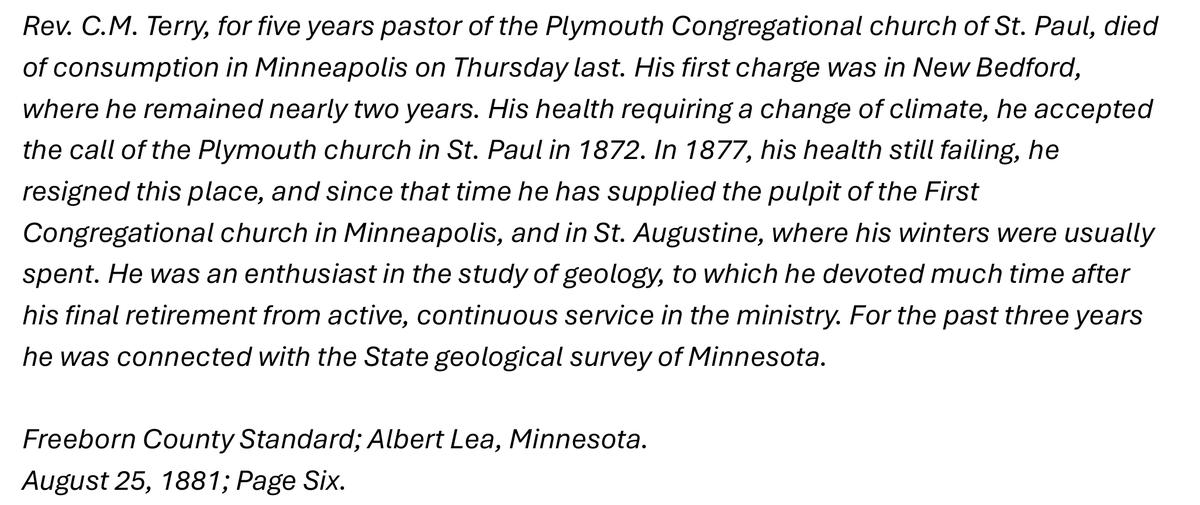
Albert Lea paper's notice of Terry's death - August 25, 1881
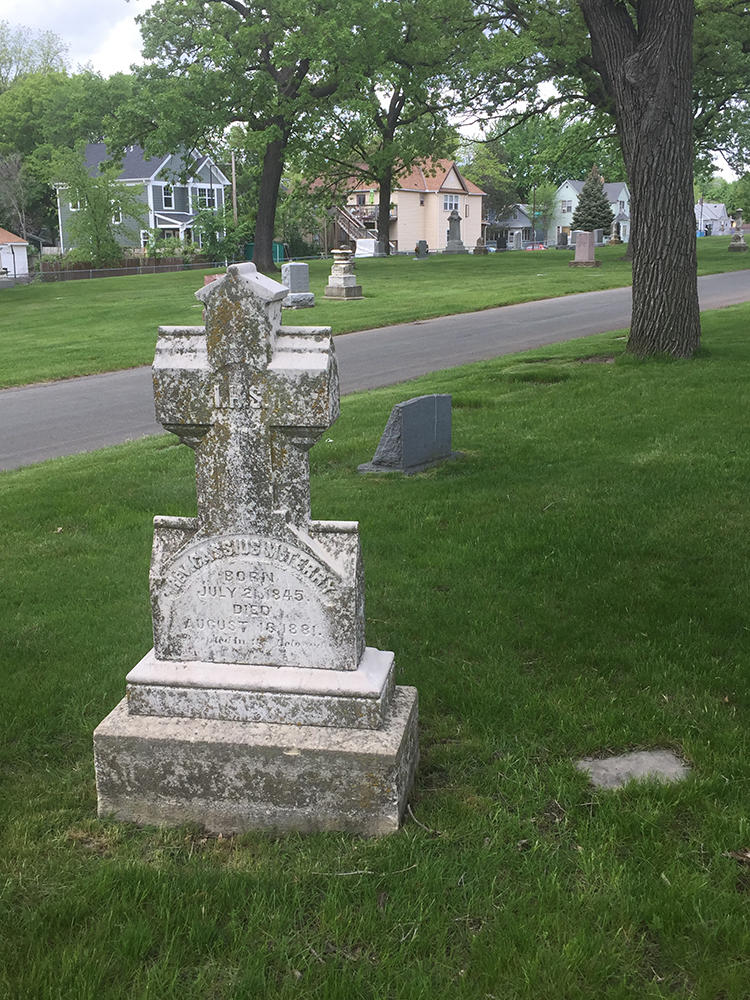
Cassius Marcus Terry’s grave at Oakland Cemetery in Saint Paul, Minnesota. The flat, worn stone on the right marks the site of Edward Sweet Terry’s grave, Cassius and Emily’s only child who died at five month’s age shortly after the Terrys arrived in Saint Paul. Although Emily’s name is inscribed on the back of Cassius’ stone, she is not buried here. Per her wishes, her remains were cremated and her ‘ashes thrown to the wind’ on a hill where she once collected ferns. However, Emily asked for her name to be added to Cassius’ marker in honor of the few but happy years they spent together.
Coincidentally, the dark stone behind the Terry monument marks the grave of William Illingworth, the photographer who accompanied Custer and Cardigan on the 1874 Black Hills Expedition.
Although we do not know when or how the Custers and Terrys met, it was likely through Armstrong’s commanding officer, General Alfred Howe Terry. Despite sharing surnames, if the general and reverend were related, it was a distant tie. Hence, geography is more likely to have played a role than genetics. The army’s Department of Dakota headquarters was at the corner of Fourth and Wabasha, a half mile from the Plymouth Congregational Church. General Terry lived at 130 Summit Avenue, only two blocks west of the church and Armstrong’s immediate superior, Samuel Davis Sturgis, lived next door at 138 Summit Avenue. Hence Armstrong and Libbie may have attended Cassius’ services when Armstrong reported to headquarters, visited his commanders, or during the many times the couple stayed in Saint Paul while travelling. While Armstrong was raised a Methodist, Libbie was Presbyterian and the couple married in a Presbyterian church. Although schisms had developed between Congregationalists and Presbyterians in the leadup to the Civil War, a decade after the war those rifts had healed to the point that Cassius served a Congregational church in St. Paul and a Presbyterian one in St. Augustine, Florida.
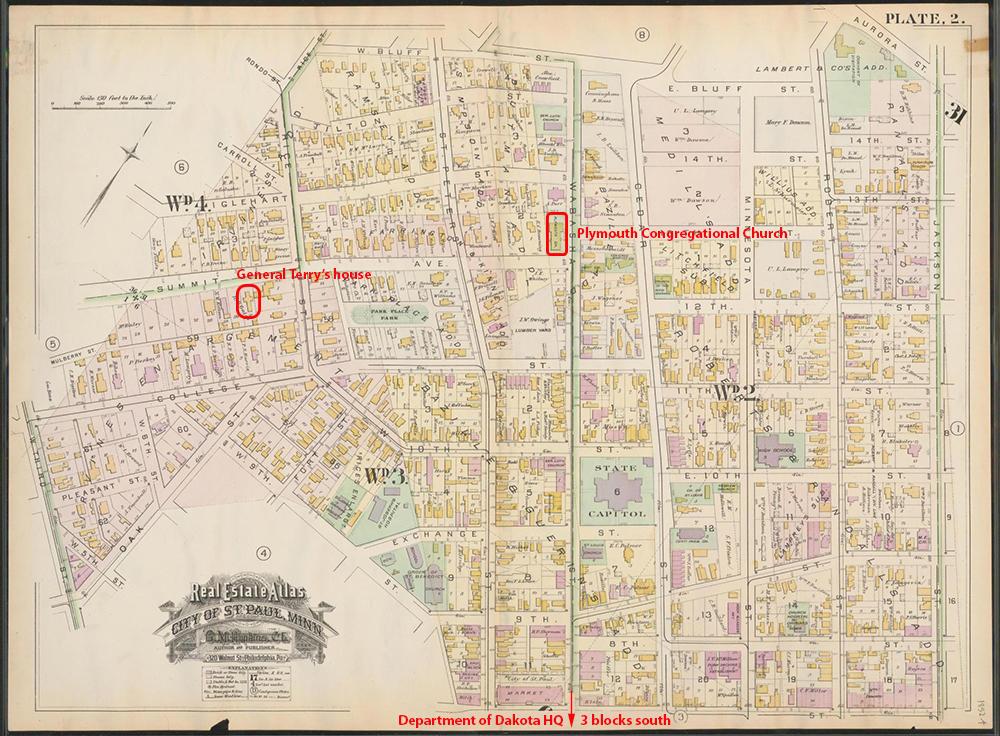
1885 map of Saint Paul's Ward 3 showing location of the Terry's Plymouth Congregational Church and location of General Alfred Howe Terry's home. Colonel Samuel Davis Sturgis lived next door to the General. The headquarters of the army's Department of Dakota were three blocks south of the map on Wabasha.
Despite their different careers, Cassius and Armstrong shared many traits. Both men were charismatic leaders, with brothers one another’s age, and who married remarkably intelligent, talented women who were willing to flout conventions to accompany their husbands in the field. Hence, once they met, the two men were almost destined to become friends or rivals - and luckily for Cardigan it turned out to be the former.
Cardigan joined the Terry household in 1876 while they were living in Saint Paul. The Terrys maintained no permanent address throughout their time in the Twin Cities, moving at least eight times in the nine years here. Hence Cardigan moved with the Terrys from dwelling to dwelling, and possibly accompanied them on their journeys to regain Cassius’ health. In published histories, Cassius and Emily were Cardigan’s last owners. Upon his death they had Cardigan stuffed and donated to the University of Minnesota’s General Museum where Cassius worked the last two years of his life.
However, those histories were wrong.
